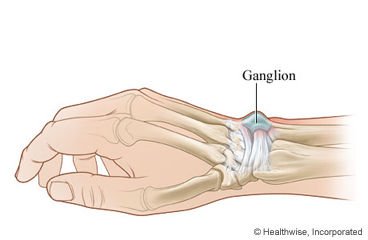Ganglions in Children: Care Instructions
Overview

A ganglion is a small sac, or cyst, filled with a clear fluid that is like jelly. A ganglion may look like a
bump on the hand or wrist. It also can appear on the feet, ankles, knees, or shoulders. It is not cancer. A
ganglion can grow out of the protective area, or capsule, around a joint. It also can grow on a tendon sheath,
which covers the ropelike tendons that connect muscle to bone. A ganglion may hurt or cause numbness if it
presses on a nerve.
Many ganglions do not need treatment, and they often go away on their own. But if a ganglion hurts, causes
numbness, or limits activity, the doctor may want to drain it with a needle and syringe or remove it with
minor surgery.
Follow-up care is a key part of your child's treatment and safety. Be sure to make and go to all
appointments, and call your doctor if your child is having problems. It's also a good idea to know your
child's test results and keep a list of the medicines your child takes.
How can you care for your child at home?
-
Have your child wear a wrist or finger splint as directed by the doctor. It will keep the wrist or hand
from moving and help reduce the fluid in the cyst. This may be all your child needs for the ganglion to
shrink and go away.
-
Do not smash a ganglion with a book or other heavy object. You may break a bone or otherwise injure your
child's wrist by trying this folk remedy, and the ganglion may return anyway.
-
Do not try to drain the fluid by poking the ganglion with a pin or any other sharp object. You could cause
an infection.
When should you call for help?
 Call your
doctor now or seek immediate medical care if:
Call your
doctor now or seek immediate medical care if:
Watch closely for changes in your child's health, and be sure to contact your doctor if:
Current as of: July 17, 2023
Content Version: 14.0
Care instructions adapted under license by your
healthcare professional. If you have questions about a medical condition or this instruction, always ask
your healthcare professional. Healthwise, Incorporated disclaims any warranty or liability for your use of
this information.